Year 6 Melbourne Diagnostic Test
Quiz Summary
0 of 30 Questions completed
Questions:
Information
You have already completed the quiz before. Hence you can not start it again.
Quiz is loading…
You must sign in or sign up to start the quiz.
You must first complete the following:
Results
Results
0 of 30 Questions answered correctly
Your time:
Time has elapsed
You have reached 0 of 0 point(s), (0)
Earned Point(s): 0 of 0, (0)
0 Essay(s) Pending (Possible Point(s): 0)
Categories
- Not categorized 0%
- 1
- 2
- 3
- 4
- 5
- 6
- 7
- 8
- 9
- 10
- 11
- 12
- 13
- 14
- 15
- 16
- 17
- 18
- 19
- 20
- 21
- 22
- 23
- 24
- 25
- 26
- 27
- 28
- 29
- 30
- Current
- Review
- Answered
- Correct
- Incorrect
-
Question 1 of 30
1. Question
The American Revolution was a significant event in American history, taking place between 1765 and 1783. It was a political and military struggle in which thirteen British colonies in North America united to break away from British rule and form an independent nation, the United States of America. The Revolution was sparked by a series of taxes imposed by the British government, as well as by a desire for greater political and economic freedom.
One of the key figures in the American Revolution was George Washington, who served as the commander-in-chief of the Continental Army during the war. He led American forces to victory against the British, and he later became the first President of the United States. Another important figure in the Revolution was Thomas Jefferson, who wrote the Declaration of Independence, which outlined the colonists’ reasons for seeking independence.
When did the American Revolution take place?
A: 1765-1783
B: 1775-1787
C: 1783-1789
D: 1789-1795
E: None of these
CorrectIncorrect -
Question 2 of 30
2. Question
The American Revolution was a significant event in American history, taking place between 1765 and 1783. It was a political and military struggle in which thirteen British colonies in North America united to break away from British rule and form an independent nation, the United States of America. The Revolution was sparked by a series of taxes imposed by the British government, as well as by a desire for greater political and economic freedom.
One of the key figures in the American Revolution was George Washington, who served as the commander-in-chief of the Continental Army during the war. He led American forces to victory against the British, and he later became the first President of the United States. Another important figure in the Revolution was Thomas Jefferson, who wrote the Declaration of Independence, which outlined the colonists’ reasons for seeking independence.
What was the main goal of the American Revolution?
A: To break away from British rule and form an independent nation
B: To form a new colony
C: To gain control of Canada
D: To become a British Province
E: None of these
CorrectIncorrect -
Question 3 of 30
3. Question
The American Revolution was a significant event in American history, taking place between 1765 and 1783. It was a political and military struggle in which thirteen British colonies in North America united to break away from British rule and form an independent nation, the United States of America. The Revolution was sparked by a series of taxes imposed by the British government, as well as by a desire for greater political and economic freedom.
One of the key figures in the American Revolution was George Washington, who served as the commander-in-chief of the Continental Army during the war. He led American forces to victory against the British, and he later became the first President of the United States. Another important figure in the Revolution was Thomas Jefferson, who wrote the Declaration of Independence, which outlined the colonists’ reasons for seeking independence.
What was the main cause of the American Revolution?
A: Taxes imposed by the British government
B: A desire for greater political and economic freedom
C: A desire for greater religious freedom
D: A desire for greater social freedom
E: All of these
CorrectIncorrect -
Question 4 of 30
4. Question
The American Revolution was a significant event in American history, taking place between 1765 and 1783. It was a political and military struggle in which thirteen British colonies in North America united to break away from British rule and form an independent nation, the United States of America. The Revolution was sparked by a series of taxes imposed by the British government, as well as by a desire for greater political and economic freedom.
One of the key figures in the American Revolution was George Washington, who served as the commander-in-chief of the Continental Army during the war. He led American forces to victory against the British, and he later became the first President of the United States. Another important figure in the Revolution was Thomas Jefferson, who wrote the Declaration of Independence, which outlined the colonists’ reasons for seeking independence.
Who was the commander-in-chief of the Continental Army during the American Revolution?
A: George Washington
B: Thomas Jefferson
C: John Adams
D: James Madison
E: None of these
CorrectIncorrect -
Question 5 of 30
5. Question
The American Revolution was a significant event in American history, taking place between 1765 and 1783. It was a political and military struggle in which thirteen British colonies in North America united to break away from British rule and form an independent nation, the United States of America. The Revolution was sparked by a series of taxes imposed by the British government, as well as by a desire for greater political and economic freedom.
One of the key figures in the American Revolution was George Washington, who served as the commander-in-chief of the Continental Army during the war. He led American forces to victory against the British, and he later became the first President of the United States. Another important figure in the Revolution was Thomas Jefferson, who wrote the Declaration of Independence, which outlined the colonists’ reasons for seeking independence.
What was the Declaration of Independence?
A: A document outlining the colonists’ reasons for seeking independence
B: A treaty signed between the British and the American colonies
C: A document outlining the British government’s reasons for imposing taxes
D: A document outlining the American colonies’ reasons for seeking reconciliation with Great Britain
E: None of these
CorrectIncorrect -
Question 6 of 30
6. Question
The Solar System is the collection of all the objects that orbit the Sun. These objects include the eight planets, their moons, and various other celestial bodies such as comets and asteroids. The Solar System is also home to the Sun, a massive star that provides the energy that sustains life on Earth.
The planets in the Solar System can be divided into two main categories: the inner planets and the outer planets. The inner planets, also known as the terrestrial planets, include Mercury, Venus, Earth, and Mars. These planets are primarily composed of rock and metal, and are relatively close to the Sun. The outer planets, also known as the gas giants, include Jupiter, Saturn, Uranus, and Neptune. These planets are much larger than the inner planets and are primarily composed of gas and ice.
The Solar System is located in the Milky Way galaxy, which is a vast collection of stars, gas, and dust. The Solar System is located near the edge of one of the spiral arms of the Milky Way, and it is estimated to be about 25,000 light-years from the galactic center.
What is the Solar System?
A: The collection of all the objects that orbit the Sun
B: The collection of all the stars in the galaxy
C: The collection of all the planets in the galaxy
D: The collection of all the moons in the galaxy
E: None of these
CorrectIncorrect -
Question 7 of 30
7. Question
The Solar System is the collection of all the objects that orbit the Sun. These objects include the eight planets, their moons, and various other celestial bodies such as comets and asteroids. The Solar System is also home to the Sun, a massive star that provides the energy that sustains life on Earth.
The planets in the Solar System can be divided into two main categories: the inner planets and the outer planets. The inner planets, also known as the terrestrial planets, include Mercury, Venus, Earth, and Mars. These planets are primarily composed of rock and metal, and are relatively close to the Sun. The outer planets, also known as the gas giants, include Jupiter, Saturn, Uranus, and Neptune. These planets are much larger than the inner planets and are primarily composed of gas and ice.
The Solar System is located in the Milky Way galaxy, which is a vast collection of stars, gas, and dust. The Solar System is located near the edge of one of the spiral arms of the Milky Way, and it is estimated to be about 25,000 light-years from the galactic center.
What is the energy source that sustains life on Earth?
A: The Sun
B: The Moon
D: Saturn
E: None of these
CorrectIncorrect -
Question 8 of 30
8. Question
The Solar System is the collection of all the objects that orbit the Sun. These objects include the eight planets, their moons, and various other celestial bodies such as comets and asteroids. The Solar System is also home to the Sun, a massive star that provides the energy that sustains life on Earth.
The planets in the Solar System can be divided into two main categories: the inner planets and the outer planets. The inner planets, also known as the terrestrial planets, include Mercury, Venus, Earth, and Mars. These planets are primarily composed of rock and metal, and are relatively close to the Sun. The outer planets, also known as the gas giants, include Jupiter, Saturn, Uranus, and Neptune. These planets are much larger than the inner planets and are primarily composed of gas and ice.
The Solar System is located in the Milky Way galaxy, which is a vast collection of stars, gas, and dust. The Solar System is located near the edge of one of the spiral arms of the Milky Way, and it is estimated to be about 25,000 light-years from the galactic center.
Which of the following planets are known as the terrestrial planets?
A: Mercury, Venus, Earth, and Mars
B: Jupiter, Saturn, Uranus, and Neptune
C: Mercury, Venus, Jupiter, and Mars
D: Earth, Mars, Uranus, and Neptune
E: None of these
CorrectIncorrect -
Question 9 of 30
9. Question
The Solar System is the collection of all the objects that orbit the Sun. These objects include the eight planets, their moons, and various other celestial bodies such as comets and asteroids. The Solar System is also home to the Sun, a massive star that provides the energy that sustains life on Earth.
The planets in the Solar System can be divided into two main categories: the inner planets and the outer planets. The inner planets, also known as the terrestrial planets, include Mercury, Venus, Earth, and Mars. These planets are primarily composed of rock and metal, and are relatively close to the Sun. The outer planets, also known as the gas giants, include Jupiter, Saturn, Uranus, and Neptune. These planets are much larger than the inner planets and are primarily composed of gas and ice.
The Solar System is located in the Milky Way galaxy, which is a vast collection of stars, gas, and dust. The Solar System is located near the edge of one of the spiral arms of the Milky Way, and it is estimated to be about 25,000 light-years from the galactic center.
Which of the following planets are known as the gas giants?
A: Mercury, Venus, Earth, and Mars
B: Jupiter, Saturn, Uranus, and Neptune
C: Mercury, Venus, Jupiter, and Mars
D: Earth, Mars, Uranus, and Neptune
E: None of these
CorrectIncorrect -
Question 10 of 30
10. Question
The Solar System is the collection of all the objects that orbit the Sun. These objects include the eight planets, their moons, and various other celestial bodies such as comets and asteroids. The Solar System is also home to the Sun, a massive star that provides the energy that sustains life on Earth.
The planets in the Solar System can be divided into two main categories: the inner planets and the outer planets. The inner planets, also known as the terrestrial planets, include Mercury, Venus, Earth, and Mars. These planets are primarily composed of rock and metal, and are relatively close to the Sun. The outer planets, also known as the gas giants, include Jupiter, Saturn, Uranus, and Neptune. These planets are much larger than the inner planets and are primarily composed of gas and ice.
The Solar System is located in the Milky Way galaxy, which is a vast collection of stars, gas, and dust. The Solar System is located near the edge of one of the spiral arms of the Milky Way, and it is estimated to be about 25,000 light-years from the galactic center.
In which galaxy is the Solar System located?
A: The Milky Way
B: The Andromeda
C: The Virgo
D: The Triangulum
E: None of these
CorrectIncorrect -
Question 11 of 30
11. Question
Meat is to vegetarian as liquor is to ………….
A: Introvert
B: Save
C: Teetotaler
D: Irrational
CorrectIncorrect -
Question 12 of 30
12. Question
Which of the following is most similar in meaning to Luminary?
A: Disrespect
B: Idle
C: Oblivion
D: Celebrity
CorrectIncorrect -
Question 13 of 30
13. Question
Assume that some pencil are books and all books are chair. Then
A. All books are pencil.
B. Some chairs are pencils.
C. No chair is a pencil.
D: Cannot say anythingCorrectIncorrect -
Question 14 of 30
14. Question
What come next in the series
4 9 16 25 __ ?A: 35
B: 36
C: 40
D: 42
CorrectIncorrect -
Question 15 of 30
15. Question
Find the two statements that together prove:
“Spinners helped Australia to win T20 against India.”
1: India scored 200 Runs by bating first.
2: Batters of Australia got out early.
3: Spinners of Australia scored 160 Runs in second inning.
4: Australia won the match.
5: Indian captain was not happy with the performance of his bowlers.A: 1 & 3
B: 2 &4
C: 3 & 5
D: 2 & 3
E: 3 & 4
CorrectIncorrect -
Question 16 of 30
16. Question
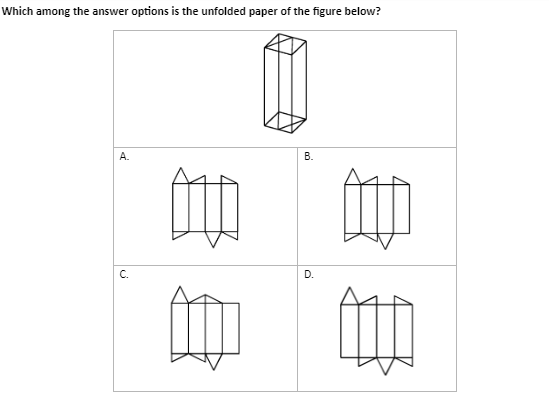 CorrectIncorrect
CorrectIncorrect -
Question 17 of 30
17. Question
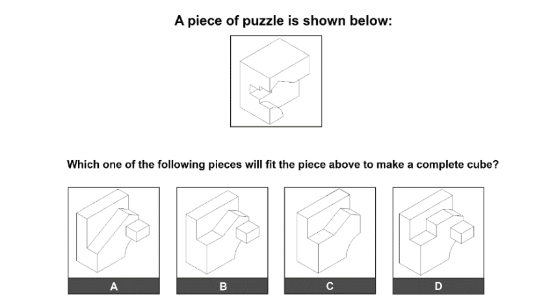 CorrectIncorrect
CorrectIncorrect -
Question 18 of 30
18. Question
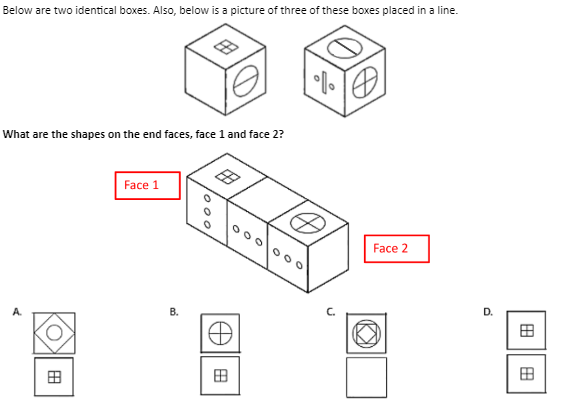 CorrectIncorrect
CorrectIncorrect -
Question 19 of 30
19. Question
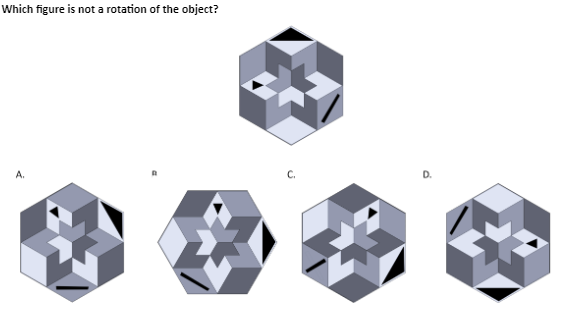 CorrectIncorrect
CorrectIncorrect -
Question 20 of 30
20. Question
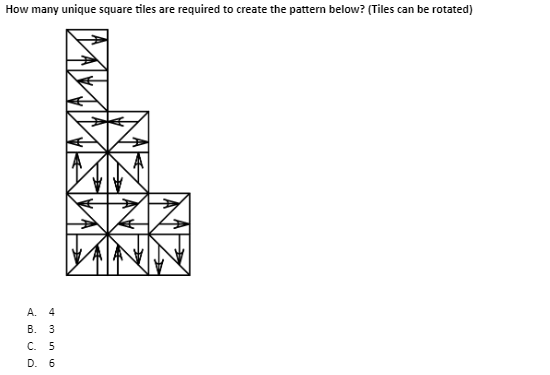 CorrectIncorrect
CorrectIncorrect -
Question 21 of 30
21. Question
- The table below gives information about the petrol consumption of the four business trips that Robert took last week.
TRIP NUMBER
DISTANCE TRAVELLED
LITRES OF PETROL CONSUMED PER KILOMETRE
1
40 kilometres
10.5
2
20 kilometres
5.25
3
20 kilometres
4.75
4
20 kilometres
5.5
What was the average (arithmetic mean) number of litres consumed per kilometre per trip of Robert’s four business trips?
A. 4.15 litres
B. 6.5 litres
C. 7.3 litres
D. 8.85 litres
E. 10 litres
CorrectIncorrect -
Question 22 of 30
22. Question
Forty-two people were eating at the cafeteria.
There were 6 more women than children and twice as many men as women eating at the cafeteria.
How many children were eating at the cafeteria?
A. 4 children
B. 6 children
C. 12 children
D. 18 children
E. 24 children
CorrectIncorrect -
Question 23 of 30
23. Question
- A manufacturer produces small, medium, and large vases only.
The table below shows the distribution of the number of vases for each size the manufacturer produced in 2019 and 2020.
2019 2020 Small 19 000 17 500 Medium 20 000 20 500 Large 21 000 22 000 The number of large vases produced by the manufacturer in 2019 constituted what fraction of the total number of vases produced by the manufacturer that year?
A. 6⁄19
B. 7⁄20
C. 3⁄7
D. 9⁄20
E. 5⁄11CorrectIncorrect -
Question 24 of 30
24. Question
- In the figure below, PQRS is a square.
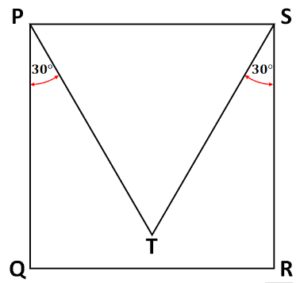
The perimeter of triangle PST is 36 centimetres.
What is the area of square PQRS?
A. 36 square centimetres
B. 72 square centimetres
C. 136 square centimetres
D. 144 square centimetres
E. It cannot be determined.
CorrectIncorrect -
Question 25 of 30
25. Question
A carpenter has a piece of lumber that is one metre in length.
The carpenter marked the lumber in fourths and also in thirds.
Then, he cut the lumber into pieces at each of these markings.
Which of the following gives all the different lengths of the pieces that the carpenter had?
I. 1⁄6 of a metre
II. 1⁄4 of a metre
III. 1⁄12 of a metre
A. I only
B. II only
C. III only
D. I and II only
E. I, II, and III
CorrectIncorrect -
Question 26 of 30
26. Question
A vendor buys brown and white sugar that she mixes and then sells at $39 per pack.
The price per pack of white sugar is thrice the price per pack of brown sugar.
If the ratio of the quantities of white and brown sugar in the mixture was 2 to 9 and the vendor makes a 30 percent profit by selling the mixture, what is the price per pack of white sugar? (Profit = Revenue – Expenses)
A. $51
B. $60
C. $63
D. $66
E. $99
CorrectIncorrect -
Question 27 of 30
27. Question
During a sale, the price of a pack of pencils is discounted 10 percent from its regular price and the price of each pen is discounted 2 percent from its regular price.
If a pack of pencils and 8 pens are at the same price at regular prices, how many percent more will it cost to buy a pack of pencils and 8 pens at their respective regular prices?
A. 2 percent
B. 6 percent
C. 10 percent
D. 12 percent
E. 15 percent
CorrectIncorrect -
Question 28 of 30
28. Question
A group of friends agreed to split evenly the cost of renting a bus for a trip.
On the day of the trip, three more of their friends decided to join the trip, and each friend who joined paid $9 less than what each person was supposed to pay.
If the cost of renting the bus was $540, what was the total number of friends joining the trip?
A. 6 friends
B. 9 friends
C. 12 friends
D. 15 friends
E. 18 friends
CorrectIncorrect -
Question 29 of 30
29. Question
John earns $700 per month at his regular job as a mechanic.
However, during the months of June, July, and August, he also works part-time as a bus driver and earns an additional $400 per month from this part-time job.
What percent of John’s annual income does he earn from his part-time job?
A. 8 percent
B. 8 1⁄3 percent
C. 11 percent
D. 12 1⁄2 percent
E. 14 percent
CorrectIncorrect -
Question 30 of 30
30. Question
The numbers of metres of the lengths of the sides of a triangle are integer values only (that is, whole number values only).
Two of the three sides of the triangle measure 1 metre and 3 metres.
Which of the following could be the length of the third side of the triangle?
A. 1 metre
B. 2 metre
C. 3 metre
D. 4 metre
E. 5 metre
CorrectIncorrect